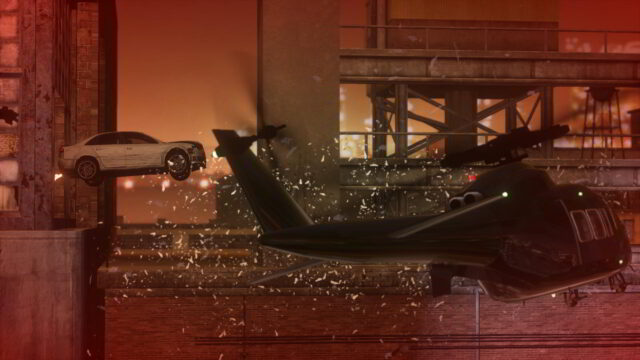
Need for Speed: The Run
Written by: Rik
Date posted: March 9, 2019
- Genre: Racing
- Developed by: EA Black Box
- Published by: Electronic Arts
- Year released: 2011
- Our score: 6
There are many matters on which future generations may judge us to have been, at best, rather careless, and an ongoing obsession with the motor car is somewhere towards the top of the list. Yes, we did know cars were bad for the environment. But we needed them to get around, you see. And for motorsport, yes. And endless Fast and Furious films. Look, it was a different time, OK? Now put on your breathing apparatus and play outside.
As the owner of a Honda Civic (with a dent in), I’m hardly blameless, but childhood fantasies of luxury car ownership, financial and other practical limitations notwithstanding, have long since been abandoned. It all seems very exciting in theory, but the reality of driving long distances in a snazzy car is less Vin Diesel or Burt Reynolds and more Jeremy Clarkson in one of those old Top Gear ‘challenges’: an overweight man with tired eyes and a sagging face, hunched into an uncomfortable driving position, guzzling down coffee to stay awake and making endless stops for petrol and toilet breaks.
In all likelihood, then, such things are best enjoyed through virtual means, preferably in a way that also downplays the technical skills required in favour of throwing virtual machinery around with a mere few presses of the joypad, and the Need for Speed series has, over the years, been reliably successful when it comes to scratching that particular itch. Although it soon veered away from its original premise of updating the Test Drive format to focus more on police chases, car customisation, street racing, and borderline-ludicrous supporting storylines, the series remained a reliable source of arcade racing fun.
However, having reinvigorated the series during the 00s, custodians Black Box lost some momentum, first with 2007s ProStreet (review pending successfully getting it running on Win64 or reluctant resurrection of wheezing Windows XP machine) which attempted, by most accounts unsuccessfully, to move to a more technical track based format, and then by 2008’s Undercover, a tired return to familiar territory which failed to capture the magic of series high-point Most Wanted.
At some stage around that time EA decided to lengthen the development cycle of the NFS games while remaining committed to an annual release schedule by farming the 2009 (SHIFT) and 2010 (Hot Pursuit) instalments out to other developers. In the meantime, Black Box would have time to refresh their take on NFS. The Run is what they came up with, wooing those fans who wanted the series to return to the open road by pitching the career mode as a coast to coast race in the manner of The Cannonball Run (but without the cannonballs, presumably [you’re fired – Ed]).
Excitement was quickly tempered however by news of the addition of a movie-style story and out-of-vehicle quick-time events, and some fairly harsh reviews followed. Regular readers, if indeed they exist, may recall some unfavourable opinions being recorded here a few years ago, with your correspondent dubbing the game – hilariously – Need for Speed: The Mess (alternative rejected joke title: Need for Speed: [I’ve Got] The Run[s]). More amusing than my own poor attempts at humour was the comment left by reader and one-time contributor Allard (formerly known as RT), which still really tickles me for some reason: “Now here’s one nobody, and I mean nobody, liked”. However, recent experience with the misleadingly-titled OutRun 2006: Coast 2 Coast persuaded me to give The Run another go, because I had admired its ambition, if not always the execution, first time around.
And although I did grumble at the time, the core of the game basically does what it says on the tin. Need for Speed: The Run does indeed allow you to race across the USA from coast to coast (San Francisco to New York), replacing the incessant and some might say repetitive grind of previous city-based NFS games with something that actually feels like a journey from one place to another. There are 10 stages, each representing a particular area of the US, and usually a handful of individual events take place within each stage. The nature of The Run means that point-to-point racing is always the order of the day, although different elements are included during events: sometimes you need to make up a certain number of places (an almost inexplicable 200 racers are supposedly taking part – you start at the back, and are assigned several arbitrary intermediate goals); sometimes it’s a timed challenge; and sometimes the police are involved. In all honesty, there’s not a lot here that will be entirely unfamiliar to fans of previous Black Box titles, and it’s stringing things together as a presentation of a continuous race that’s the main original element here. It has to be said that this is done well: you do feel like you’re racing across the US, there are rural highways as well as city based challenges, and each stage feels distinctive.
However, what The Run does right is frequently obscured and undermined by different flavours of what might best be described as unnecessary bullshit. Firstly, the attached story isn’t particularly edifying stuff. The main character, Jack (they’re always called Jack), is a disagreeable tit with no discernible charisma or personality, who almost certainly deserves to be crushed into a cube inside a Porsche, although fortunately for him you aren’t to know that when you find him in such circumstances during the opening scenes. In the interests of being able to start the game, save him you must, during the first of a handful of out-of-car segments which employ so-called quick time events in the manner of Fahrenheit (but rather less demanding than those – it’ more like ‘Press X to escape from car crusher’ and my main difficulty was not instinctively knowing which button is which on the Xbox controller).
Anyway, Jack then enters The Run after his friend/acquaintance Sam persuades him to do so, promising to take care of the problem that caused him to be at the junkyard in the first place (whatever that might be) and offering a cut of the winnings in exchange for his co-operation. Fans of films that involve cross country road racing will know that there’s rarely a reason for doing so that isn’t contrived and unbelievable (see The Run: East Bound and Down for more), but even by these low standards, The Run‘s setup doesn’t make a lot of sense. Some of my questions would include: what is Jack’s problem? If it’s financial, then could he not sell one of his garage full of cars that we see at the start of the game? How exactly does Sam make a lot of money betting on Jack’s races, as we’re told? Why would Jack settle for a 10% cut of the winnings when he could presumably take care of any problem with 100% of it? And who is actually in a position to pay $25 million to the winner of a such a race anyway? (Maybe there’s an entry fee, which Sam puts up on Jack’s behalf, and that money is pooled to create the prize fund, which would mean each racer has to put up at least $125,000…but it’s entirely possible that I’ve spent too much time thinking about this).Anyway, such questions aside, the main feeling about the story is that it’s underdeveloped, whether by accident or design. Cut-scenes are pretty limited, and blanks are often filled in by brief explanations on loading screens. Opponents are given even less context than in Most Wanted or Carbon: it’s usually a paragraph of biography, then a race against them, then they may return, or not, at a future stage. Meanwhile, interactions between Jack and Sam are extremely perfunctory: “Be careful Jack!” “Ok, thanks.” I suppose it does mean that you’re spared extended periods of poor quality exposition or prolonged exposure to an extremely annoying main character, but it does rather make you wonder if it was actually meant to be like this, or whether some things had to be cut along the way.
The story also doesn’t combine all that comfortably with a free-wheeling road race. Without spoiling things too much, there are various movie-style flashpoints where you’re ripped from your chosen vehicle and forced to seek an alternative. So while there are lots of cars to choose from while completing The Run, it’s not always a free choice: you will choose from Jack’s garage at the start, the luxury selection parked on the street in Vegas, or the Audis available at the Chicago dealership (ugh). You can switch cars fairly regularly, and the mechanism for doing so is stopping at one of the many Shell garages (double ugh) located along the route, where you can hop into any unlocked vehicle at the appropriate performance tier. Given how ludicrous and unrealistic that is, you might think an equally unrealistic but more satisfying alternative would be for Jack to choose a car from the full range at the start and use it to complete The Run until the finish. An in-game ‘hint’ on one of the loading screens even suggests choosing different vehicles according to the type of stage you’re driving, which seems entirely at odds with the whole concept of The Run, but then I happen to be very attached to road movies where the protagonist drives one vehicle throughout, rather than one where they hop from one to another, so this could be a personal thing.
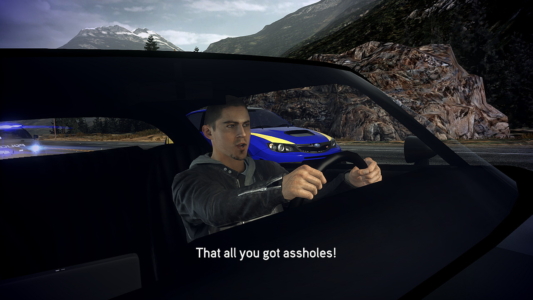
Here’s Jack: kind of a cross between Harsh Times Christian Bale and Matthew Fox from Lost. (The subtitles often contain minor typos, because either the person doing it got bored by his dialogue, or they were written ‘in character’ – this is a guy who’s so obsessed with driving, he can’t be bothered to spell).
Speaking of cars, many do need to be unlocked, and some will forever remain out of reach, because they’re only available in the limited edition version of the game that is no longer sold. As previously acknowledged in coverage of newer titles, I’m several years late to the debate about DLC and paid add-ons, my lazy assumption being that by the time cheapskates like me get around to buying something the special edition with everything rolled into one package is offered as standard. That’s not the case here, and I particularly dislike the game’s method of showing you the unavailable vehicles that you’ll never have access to rather than including them only in the enhanced edition. Others require you to complete multiplayer challenges, from which I abstain, and the reward such a course of action is repeated reminders from the game that you don’t have any friends.
Finally under the BS heading (yes, we’re still there), we also have the weird logging system which is again all geared around multiplayer, and how your times compare with those of your non-existent friends who are also still playing a Need for Speed game from seven years ago. In a sense, that’s fair enough (they do, I believe, intend for these games to be bought and played at release) but it also seems very unreliable when it comes to logging your own time and comparing it to previous bests (it’ll say you’ve beaten your previous best by an unlikely margin, or say you have but then not reflect this on the leaderboard). The Run is short – a good thing, I would argue, and we’ll get to that – but part of the fun of repeat plays would surely be switching vehicles, difficulty levels etc and seeing what times you could come up with. Perhaps it’s just not reasonable to expect a modern title to have a basic high score table like in, say, Stunts as well as the social-media-play-with-your-friends stuff, but for me it would have made sense.
There are other gripes with the actual driving, too. Somewhere between Most Wanted and Undercover the handling went a bit wrong in these games, and here it’s extremely heavy, with most vehicles feeling rather tank-like, while the default behind-car view is set very close and zooms in disconcertingly while cornering. The system of earning nitrous by driving a bit dangerously also remains, as does the need to constantly use it, which is something that you’d have hoped they’d have found a way around, or an alternative for, by now.
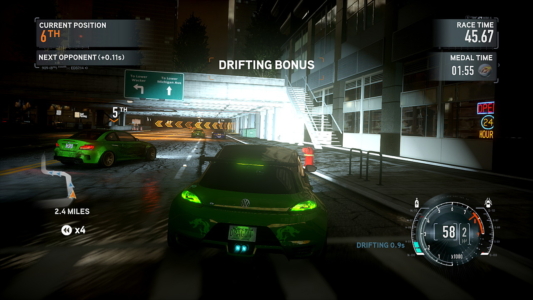
There are echoes of earlier Black Box efforts in the various challenges, in this case, of NFS: Underground.
Meanwhile, the positive of there being no invisible walls around the road is countered by the fact that the game is occasionally overzealous in judging you to have gone too far off course and resets you with a small time punishment when you cut a corner. That’s separate to the reset checkpoint system used to deal with race-ending crashes, whereby the action rewinds to the last checkpoint so you can try again. This can also be invoked manually if you judge you’ve messed something up and/or figure that you’re not going to win, and the difficulty level determines the number per event that you’re permitted.
Still, despite all its faults, The Run is a game you can play again and again. The short run time and gentle difficulty makes it possible, and for once you don’t feel like everything has been strung out through endless repetition of the same elements. There are moments of pure joy, too, be it weaving through traffic on the Altamont Pass with wind turbines lining the highway, or the amazing section in the Rocky Mountains of Colorado. And not only did I play The Run through multiple times, I also found myself dipping into the individual challenge mode, which admittedly involves significant recycling of the same stages used in the career mode, in order to level up and unlock some more vehicles for another go at The Run itself.
When I first played the game a few years ago, my general disappointment that The Run wasn’t everything that I’d hoped meant that I dismissed everything outside the main story mode as unnecessary padding, and it could perhaps be argued that grinding through races to unlock cars is no less dirty than hiding them behind multiplayer modes. For me, it extended only to trying to achieve gold medals in all timed challenges, which I arguably would/should have done anyway if I intended to write up a full review, unlocking several new cars along the way. And there are some great moments in these challenges, and my position soon changed from viewing them as little more than a dull chore to something broadly more positive.
As for your ‘Driver Level’, this is a largely superficial RPG element, with so-called driving abilities like unlocking nitrous and drafting, long-established staples of the series, made available at the very early stages of progress. A handful of additional cars are unlocked by levelling up later on, but most of the higher level unlocks are largely useless logos and backgrounds for the online profile you’re supposed to care so much about.
Anyway, having completed all challenges, I was looking forward to another go at The Run with a higher difficulty and a car with more slippery handling. And, yes, maybe that car was a black Pontiac Firebird with gold trim to fulfil long-standing Smokey and the Bandit fantasies. It was indeed a good time, with the shortcomings of the car making things interesting at various points, and I was all geared up for a spirited defence of the game until I arrived at the tedious final third, where the racing plays second fiddle to daft GTA/Driver style antics – avoiding gunfire, driving through warehouses and along train tracks, avoiding exploding barrels – and it gets really rather annoying.
So am I still going to defend The Run? Yes, I think so. Many of its elements are stuck in the mid 00s, it suffers in comparison to immediate predecessor, Hot Pursuit (a comparison it invites due to deliberate callbacks during police chases), and it’s a shame about the story and the other dismal nonsense that lets it down, but the career mode broadly succeeds as a celebration of the open road and a race across America. It looks good, too, using DICE’s Frostbite engine also employed in their Battlefront series, and after a couple of forgettable soundtracks, The Run is somewhat of a return to form in this regard too (although licensing On The Road Again by Canned Heat is perhaps a little too on the nose). While many previous NFS games bulked out their career modes with repetitive tasks, leaving you exhausted at the end of even the very best of them, The Run is one that you’re more likely to find yourself going back to.

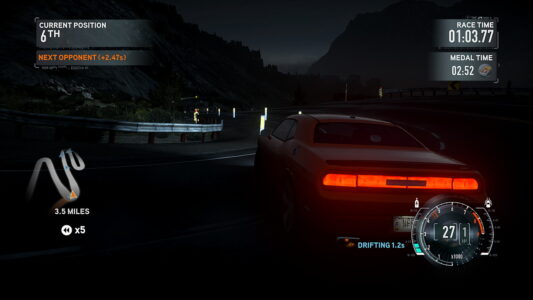
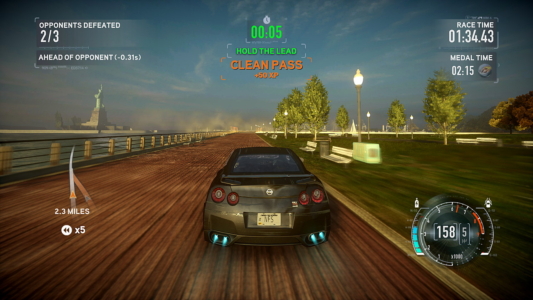
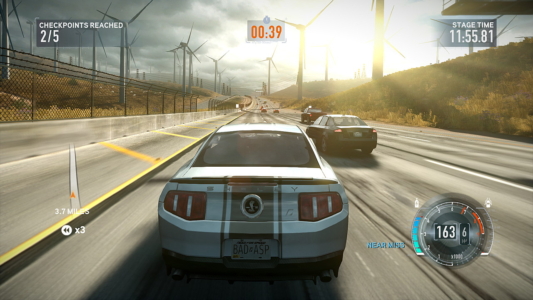
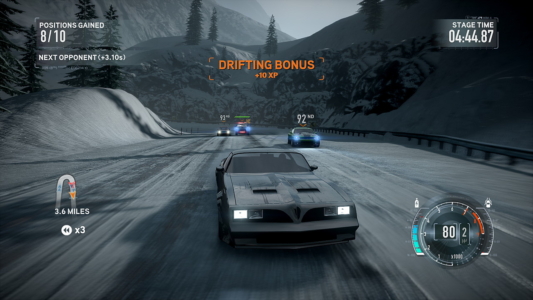

 Posts
Posts
“Regular readers, if indeed they exist” : they do. 😉
March 9, 2019 @ 10:10 pm
Hi Rik,
This will be a looong comment!
At the time of The Run’s release, I didn’t have a PC capable of “running” it. Today yes, and after reading this review of yours, armed with knowledge and strengthened in spirit, I decided to give it a try.
The Run is really nice to see, they did a great job with the graphics. And, this time, I didn’t snub the musical part, as I do every time I play a Need For Speed: from Underground onwards, there are few bands in the series that I like, but that’s because I’m very selective about all musical genres (a decade-long Death Metal band of mine and Peter Gabriel’s complete physical discography might be an indication).
Therefore, I prefer to turn off the lisenced music and hear the roar of the engines. Best music ever!
Speacking of music, here we have the tracks that are appropriate for each stretch. And there is a nice selection of songs that have made history!
As for the actual game, being one that the series has followed since the very first chapter, here I can share your observation on the fact that there is a real feeling of an open road and a “coast to coast” race. There is a different air, compared to the previous chapters, which had a much tighter pace.
Regarding the difficulty, I went fast at medium level, until I got to the more advanced stages. In that case, you have to make careful car choices, because some types are more useful on a particular route than others, forcing you to choose a “specialized” type. Then, I noticed that there is too much imbalance in favor of German cars (Audi R8; in Italian, you pronounce this as “Audi Érre-Otto”, resulting in a playful “Audi ha rotto” – “Audi broke my balls”; power of language!). But maybe it’s just my impression.
I have a soft spot for the Pontiac Firebird. As a child, my grandmother’s friend, who was a doctor on merchant ships,she had brought me a model of the Firebird from Singapore. It was an all black car, like that of Knight Rider, with an inertial mechanism and the blue Phoenix on the hood and opening doors, on which there was the writing “FIREBIRD”, inside a blue flame; a model almost identical to this: https://www.pinterest.com/pin/371758144232163322/.
And the rims were identical too!
Well, on the straigh line, the Firebird of The Run is a love. However, winning against Mila in the next stage, on a winding and uphill course, was very tough for me. I couldn’t change that car, until I got to the gates of New York and had to set the difficulty to “Easy” to get through that route.
Also, you can see when the game is trying to rip you off: petrol stations are present on almost all routes, but in the last stages they exist exclusively on a single stretch of road, after which you have to get by with the car of your choice, up to the boss of that level.
Indeed, it is almost advisable to keep the car they throw in your hand: by changing the horse at the gas station, the cavalry loses its rhythm, so you are almost certainly at a loss.
Another interesting aspect is that some routes are reminiscent of the previous chapters of Need For Speed: the battles on the roads in the mountains to the Carbon, a dizzying race in the narrow streets between buildings to the Underground, a ride in the park in the autumn atmosphere to the Most Wanted, while the race against attacking SUVs is Undercover stuff.
And then, there’s Jack.
Let’s say that, in the course of the Story mode, if I could close my eyes, I wouldn’t even notice his presence. But, there was an episode, just outside Las Vegas, with the arrival of Nikki and Mila, that almost made me puke.
I mean, girls, in this genre of games, come and go, and I’m not a prude. After all, many years ago, I had unlocked all the strippers in Street Racing Syndicate; including Tila Tequila who, together with Snooki, are the living confirmation that Twitter would have tried to erase the ability to understand and want to the human species…followed by Tik Tok.
Jack, at this point, is one to butt head on his gums, to see teeth go in his subways.
Marvellous. Now I need a tea.
After all these words, did I like the game? Yes and no.
Yes, because the speed is all there (2:26 hours to my stopwatch, but they are minutes inside the game; in reality, between attempts and more, I finished it in a week, playing a couple of hours at night and the “full immersion” on a Saturday).
So, speed is what we need, and it’s there.
No, because cars are tractors (you already said that), and I feel like the developers had too much to do with the “Hollywood” side of it. It got out of hand, apparently.
I hate multiplayer, so I stick to challenges, and in this The Run has a lot to offer.
Now, after all this verbosity, I invite you to enjoy this nice stuff here: https://www.youtube.com/watch?v=eaVcpfncOWs!
Have a good Sunday evening!
June 26, 2022 @ 3:57 pm
I’d completely forgotten about the terrible Nikki and Mila scene – think I must have been forced to watch it a few times after messing up the subsequent race as it all came flooding back once you mentioned it.
(Side-note: Jack is supposed to be filling up his car at this point but he looks like he’s taking a whizz on the floor. One that he’s been holding in for a long time.)
Sounds like we both had a similar experience with The Run: it’s definitely not as bad as its reputation.
Can’t remember much about my car choices except to agree that Audis are definitely forced upon you at various points – particularly that bit where you need a car and happen upon an Audi dealership…
Hope you’re well!
June 27, 2022 @ 3:59 pm